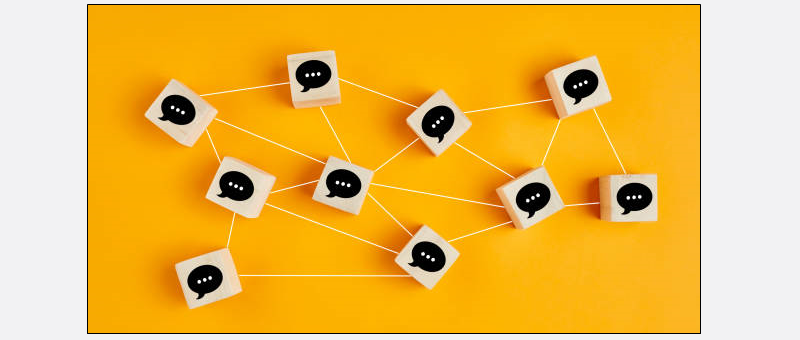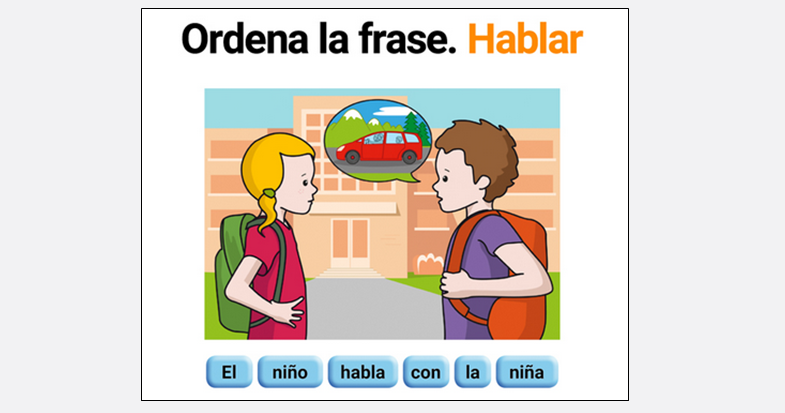Hablar (Talk/Speak)
WAYS WE CAN USE THE WORD(S)
SHARE INFORMATION: e.g., Voy a hablar con mi hermano. (I’m going to talk to my brother.)
REQUEST: e.g., ¿Puedes hablar más despacio, por favor? (Can you speak more slowly, please?)
INFORM: e.g., Hablo español. (I speak Spanish.)
ASK QUESTIONS: e.g., ¿Hablas francés? (Do you speak French?)
DIRECT ACTION: e.g., Habla más fuerte. (Speak louder.)
REFUSE: e.g., No quiero hablar de eso. (I don’t want to talk about that.)
EXPRESS PREFERENCE: e.g., Me gusta hablar de deportes. (I like to talk about sports.)
CLARIFY: De hecho, prefiero usar mi iPad para hablar. (Actually, I prefer to use my iPad to talk.)
CONJUGATIONS FOR PRESENT AND PAST (PRETÉRITO INDEFINIDO)
|
SUBJECT |
PRESENT |
PAST |
|
I |
Hablo |
Hablé |
|
You |
Hablas |
Hablaste |
|
He/She/You (Formal) |
Habla |
Habló |
|
We |
Hablamos |
Hablamos |
|
They |
Hablan |
Hablaron |
This core words activity sheet was created by Angela Rowell. It was adapted from the School Year of Core Words worksheet for “talk” by Michaela Sullivan, who can be contacted at michaelasullivan2@gmail.com.
Snack/Mealtimes: During mealtime or snack time if appropriate, the adult can advise students to not speak while they are still chewing food, e.g., “No hables con la boca llena” (Don’t talk with your mouth full).
Social regulation: During calendar and group activities, the adult can advise students to not speak while a peer is talking, e.g., “No está bien hablar cuando está presentando un compañero” (It is not nice to talk while others are presenting).
Circle Time: Adults can encourage students to ask one Wh- question to a peer. To initiate conversations, adults can use phrases such as, “¿Con quién quieres hablar hoy?” (Who do you want to talk to today?). The adult can prepare printed photos of classmates which students can use to choose/indicate who they will ask their daily question to. Once a student has already responded to a question, the adult can remove their photo from the options.
Introduction of Theme/Topic: When presenting a daily topic, the adult can say, “Hoy vamos a hablar de [name of topic]” (Today we’re going to talk about [name of topic]”).
After School: Adults can prompt students to describe their day at school using phrases such as “¿Quieres hablar de tu día?” (Do you want to talk about your day?) or “Háblame de tu excursión al museo” (Talk to me about your field trip to the museum), etc.

Initiation of Play: The adult can prompt a student to consider play with a peer, using phrases such as, “¿Quieres hablar con [name of student] para invitarlo/la a jugar?” (Do you want to talk with [name of student] to invite them to play?”
Parallel Talk: The adult can use the language stimulation strategy of parallel talk (i.e., narrating what the student is doing) during playtime. The adult can begin their narrations with phrases such as, “Voy a hablar de todas las cosas que estás haciendo” (I’m going to talk about all of the things that you’re doing).
Telephone: Students can play a game of telephone, the game in which a short message is passed from one person to the next. Students can use strategies such as: whispering, plugging headphones into their high-tech AAC device so that only one communication partner can listen to their utterance, using a low-tech communication board which only one person can see, or using sign language which only their communication partner can see. For this activity, the adult can utilize phrases such as, “En este juego, todos vamos a hablar” (In this game, we’re all going to talk) or “Tienes que hablar en voz baja” (You have to speak quietly).
Tongue Twisters: The adult can give tongue twisters to students. The tongue twisters can be repeated by students verbally or repeated via low-tech or high-tech AAC systems. The adult can create their own tongue twisters or use tongue twisters available online. The adult can give instructions such as, “Voy a hablar y luego vas a repetir lo que digo” (I’m going to talk and then you’re going to repeat what I say).
Talking Game: The adult can prepare conversation starters for students to discuss. In one version of this game, students write down or dictate their answers to pre-selected questions, students’ responses are all mixed up, and the class must then guess who each response belongs to. Materials for playing “El juego de habla” are available for free on the Teachers Pay Teachers website.

Here are some suggested books on YouTube that can assist in teaching the core word:
- Carlota no quiere hablar: By Claudine Bernardes | Children's Book Read Aloud by A jugar
- This is a book about a little girl named Carlota who struggles to talk about her emotions. Through learning about Carlota’s story, students will learn about how to healthily process and express their feelings.
- ¿Qué te contaría si pudiera hablar?: By Mick Inkpen | Children's Book Read Aloud by Los cuentos de la seño Eva
- This is the heartwarming story of what a dog would say to their owner if they were able to speak.
How I Talk: Students can practice phrases which they can use when showing their communication systems/devices to new conversational partners. The students can practice sentences such as, “Así es como hablo” (This is how I talk).
Respecting Conversational Turns: The adults can direct students to respect conversational turns by using phrases such as, “Ahora habla [name of student]” (Now [name of student] is talking).
Social Interactions: The student can use a feelings communication board to express to a conversational partner how they are feeling. The adult can remind students, “Es importante hablar de cómo nos sentimos” (It’s important to talk about how we feel).

Touching Communication Systems: Students who are comfortable can allow their peers to touch their communication system. The adult can remind students, “Así es como [name of student] habla con nosotros” (This is how [name of student] talks with us). The adult should highlight the fact that there are many ways to talk and communicate aside from verbal speech.
Do You Like It Or Not? (¿Te gusta o no?): Given a page of visual and textual options, students can color in and then discuss with their peers what their preferences are. When presenting this activity, the adult can use phrases such as, “Hoy vamos a hablar de las cosas que nos gustan y las que no nos gustan” (Today we’re going to talk about the things that we do and don’t like).
This resource (published on the lapizdeele.com website) can be viewed here.

Which language(s) do you speak?: For this activity, students can give their peers short presentations on the language(s) that they speak, e.g., “Hablo inglés y español” (I speak English and Spanish). They can say why these languages are special to them. Both monolingual and multilingual students can also say if there are any languages they would like to learn to speak.
My Favorite Conversation Topics: For this activity, students can say to the class what their favorite topics to talk about are, e.g., “Me gusta hablar de animales” (I like to talk about animals). The adult can use the topics discussed to prepare future activities.
Order the Words in the Sentence: The adult can download materials from the #Soyvisual website to facilitate an activity in which the student puts the words of a sentence in the correct order; all sentences contain the verb hablar. This resource is available here.

- El niño que no para de hablar en clase|Animated Short | By Marie Leiner
- This animated short highlights the importance of listening to others and paying attention to the opinions and words of those around you.
- El dragón Rufus aprende a respetar su turno de palabra | Animated Short| By Cuentos Infantiles
- This is an animated short about a dragon who learns how to respectfully converse with others, something which improves his ability to develop strong friendships with others.
- Alfonso y el caracol que podía hablar |Animated Short| By Tottus Perú
- This animated short teaches students about respecting animals’ natural habitats.
- No se habla de Bruno| Music Video| By DisneyMusicLAVEVO
- This is a colorful and lively music video from the Disney film Encanto.
- Toma turno para hablar | Animated Short| By Little People Latinoamérica
- This 10-minute episode from Little People Latinoamérica teaches students about the importance of turn-taking in conversation.
- Ahora hablo yo | Music Video | By Mundo Zamba
- This short and catchy song can be used alongside lessons on the importance of speaking, communication, and self-confidence.
Speech Bubble Artwork: The students can draw themselves with a speech bubble next to their faces, and in the speech bubbles, they can write or draw all of their favorite things to talk about. At the top of the page, the adult or student can write the header, “Me gusta hablar de…” (I like to talk about…) This activity can also be done with collages made from photos of students.
Subject + Verb Sentences with Hablar (#Soyvisual app): The adult can use digital text and images from the #Soyvisual app to assist the student in constructing subject + verb sentences using the core word hablar. This exercise pack is available here.

The subject + verb + direct complement version of this activity pack is available here.
Pictello: Students and adults can use the visual storytelling app Pictello to create stories about how each student’s communication system works. The stories can include as many visual images and details as students and adults would like. These are stories that students can show to new communication partners.
Tarheel Reader: Students can use Tarheel Reader to write books about how they have gained confidence in their ability to speak, express themselves, and communicate.
Recording Presentations: Students can practice their communication and speaking skills by preparing presentations on their topics of choice. The adult can then record the students giving their presentations, and share the videos with peers and the students’ families.
WORD WALL: Create a Word Wall and add hablar to the list.
READING and the Word Wall: Sound out the letters together. Have the students find the word on the AAC system.
WRITING and the Word Wall: Using a pencil or alternative pencil, have students try to type the word on the keyboard, adapted keyboard or write the word together.
Choosing Words for the Classroom Word Wall with Dr Caroline Musselwhite Video. Courtesy of Edmonton Regional Learning Consortium.